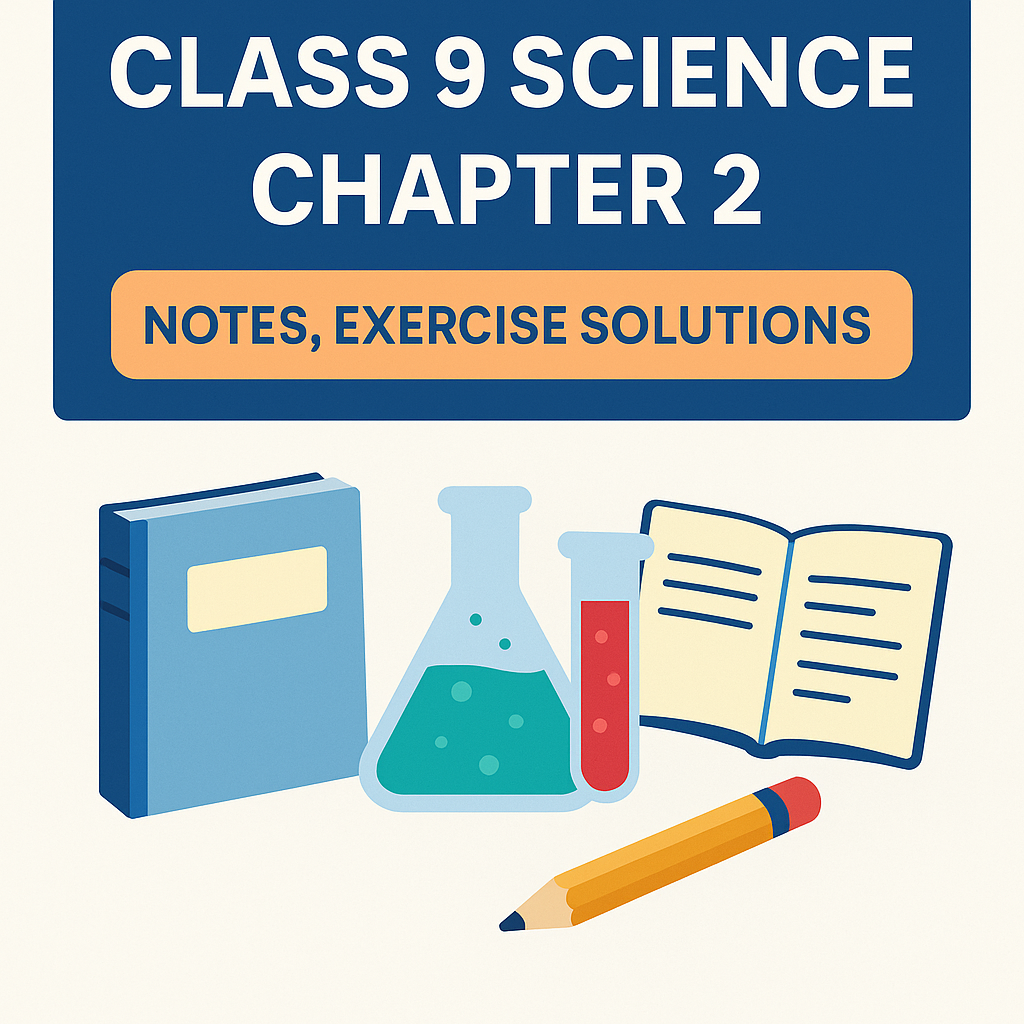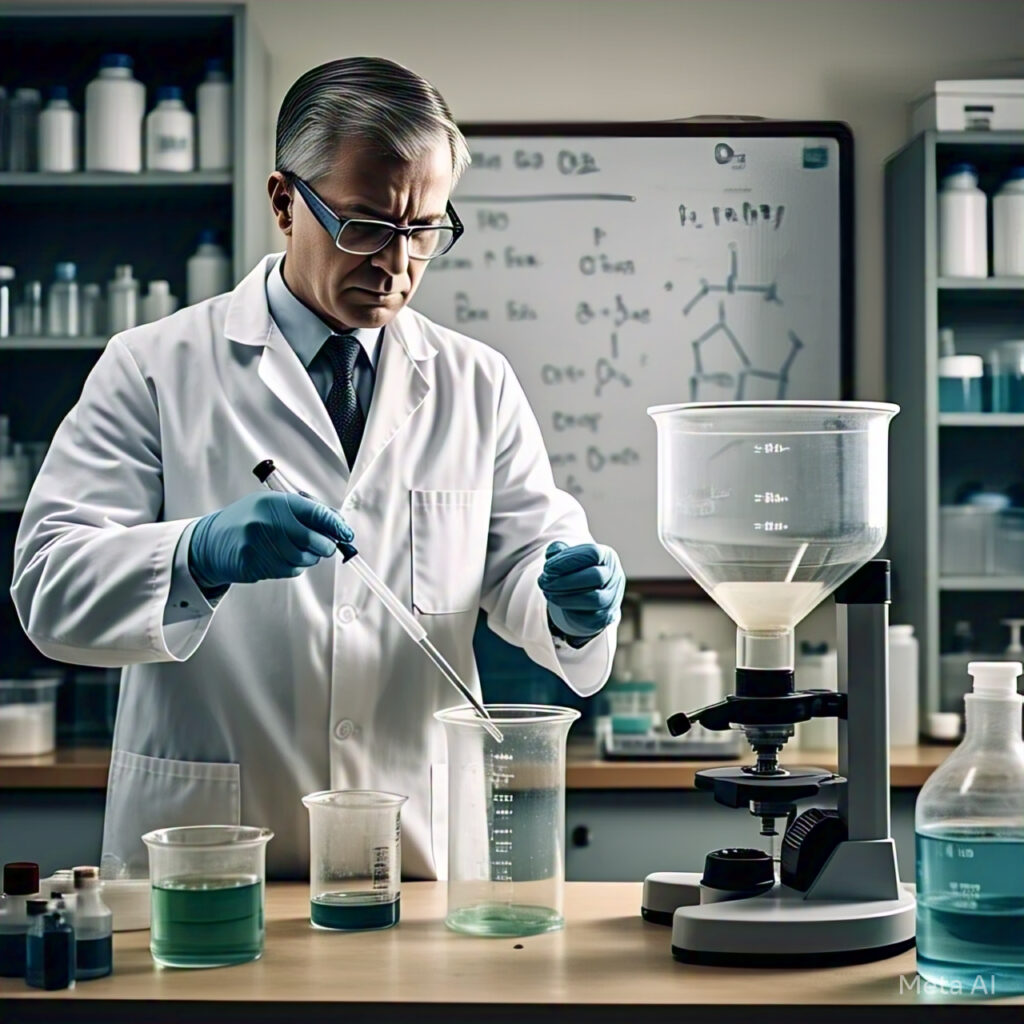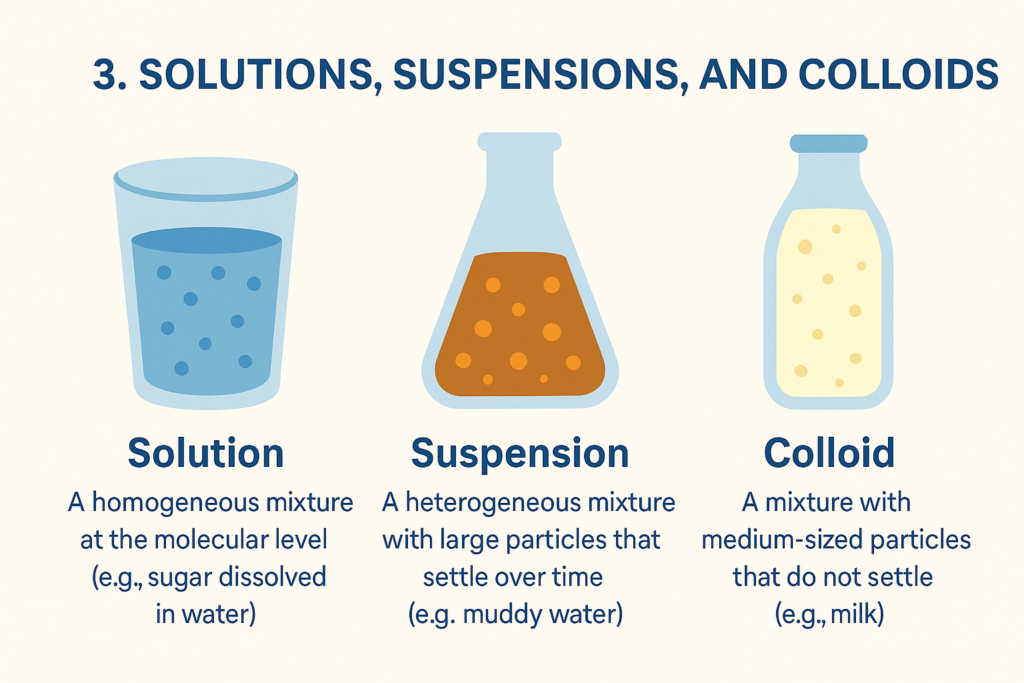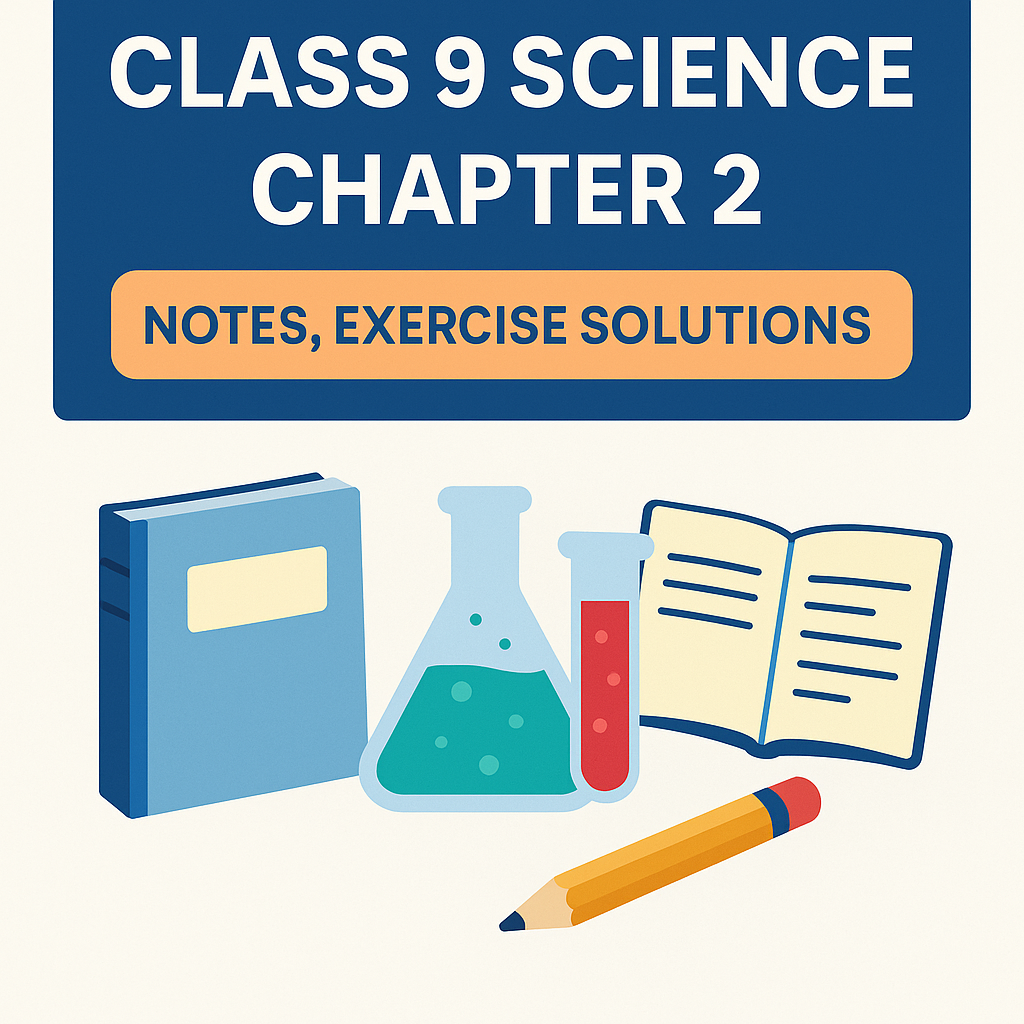Class 9 Science Chapter 2 – Notes, Exercise Solutions. Clear and concise NCERT Class 9 Science Chapter 2 notes on “Is Matter Around Us Pure?” Includes definitions, diagrams, differences, NCERT intext and exercise question-answers, and easy-to-understand flowcharts. Is Matter Around Us Pure Class 9 Notes, science class 9 chapter 2 question answer, class 9 chapter 2 science notes

Class 9 Science Chapter 2 – Notes, Exercise Solutions
Table of Contents
Class 9 Science Chapter 2 – Notes, Exercise Solutions
🧪 Key Concepts
1. Pure Substances
- Definition: A pure substance consists of only one type of particle and has a uniform composition throughout.
- Examples: Elements like iron and compounds like water.
2. Mixtures
- Definition: A mixture contains two or more substances combined in any proportion.
- Types:
- Homogeneous Mixtures: Uniform composition (e.g., salt dissolved in water).
- Heterogeneous Mixtures: Non-uniform composition (e.g., sand and water).
3. Solutions, Suspensions, and Colloids
- Solution: A homogeneous mixture at the molecular level (e.g., sugar dissolved in water).
- Suspension: A heterogeneous mixture with large particles that settle over time (e.g., muddy water).
- Colloid: A mixture with medium-sized particles that do not settle (e.g., milk).
4. Separation Techniques
- Filtration: Used to separate solid particles from liquids.
- Distillation: Separates components based on differences in boiling points.
- Chromatography: Separates substances based on their movement through a medium.
📌 Important Points
- Purity: A pure substance has a fixed composition and distinct properties.
- Mixtures: Can be separated into their components by physical methods.
- Separation Techniques: Essential for obtaining pure substances from mixtures.

📚 Chapter Notes
- Matter: Anything that has mass and occupies space.
- Element: A pure substance that cannot be broken down into simpler substances.
- Compound: A substance formed from two or more elements chemically bonded.
- Mixture: A combination of two or more substances where each retains its properties.
- Separation Techniques: Methods like filtration, distillation, and chromatography are used to separate mixtures into their components.
In Text Questions
1. What is meant by a substance?
Answer: A substance is a form of matter that has a specific composition and distinct properties. It is made up of only one type of particle and cannot be separated into other substances by physical means. Examples include elements like oxygen and compounds like water.
2. List the points of differences between homogeneous and heterogeneous mixtures.
Answer: Here is a list of key differences:
| Property | Homogeneous Mixture | Heterogeneous Mixture |
|---|---|---|
| Composition | Uniform throughout the mixture. | Non-uniform composition. |
| Visibility of Components | Components are not visible. | Components are visible and can be seen separately. |
| Separation | Cannot be separated by simple physical methods. | Can be separated by physical methods. |
| Example | Saltwater, air | Sand and water, salad |
3. Differentiate between homogeneous and heterogeneous mixtures with examples.
Answer:
- Homogeneous Mixture: A mixture that has a uniform composition and the components are evenly distributed. Example: Salt dissolved in water.
- Heterogeneous Mixture: A mixture where the components are not uniformly distributed and can be distinguished easily. Example: Oil and water.
4. How are sol, solution, and suspension different from each other?
Answer:
- Sol: A type of colloid where solid particles are dispersed in a liquid, but the particles are small and do not settle. Example: Paint.
- Solution: A homogeneous mixture where one substance is completely dissolved in another, and the particles are not visible. Example: Saltwater.
- Suspension: A heterogeneous mixture where solid particles are suspended in a liquid and eventually settle down. Example: Muddy water.

5. To make a saturated solution, 36 g of sodium chloride is dissolved in 100 g of water at 293 K. Find its concentration at this temperature.
Answer: To calculate the concentration, we can use the formula for concentration of a solution:
Concentration (in g per 100 g of solvent)=(Mass of solute/Mass of solvent)×100
Given:
- Mass of solute (NaCl) = 36 g
- Mass of solvent (water) = 100 g
Concentration=(36/100)×100=36 g per 100 g of water
Thus, the concentration of the sodium chloride solution is 36 g per 100 g of water.
6. Classify the following as chemical or physical changes:
| Change | Type of Change |
|---|---|
| Cutting of trees | Physical Change |
| Melting of butter in a pan | Physical Change |
| Rusting of almirah | Chemical Change |
| Boiling of water to form steam | Physical Change |
| Passing electric current through water and the water breaking down into hydrogen and oxygen gases | Chemical Change |
| Dissolving common salt in water | Physical Change |
| Making a fruit salad with raw fruits | Physical Change |
| Burning of paper and wood | Chemical Change |
Explanation:
- Physical Change: In a physical change, the substance undergoes a change in its physical form but its chemical composition remains the same. Examples: Melting butter, dissolving salt in water, boiling water, cutting of trees, and making a fruit salad.
- Chemical Change: In a chemical change, the substance undergoes a transformation into a different substance with a new chemical composition. Examples: Rusting of almirah, passing electricity through water to form hydrogen and oxygen, and burning paper/wood.
7. Try segregating the things around you as pure substances or mixtures.
Pure Substances:
- Water (H₂O): A compound with a fixed composition.
- Oxygen (O₂): An element with a fixed composition.
- Gold: A pure element.
- Salt (NaCl): A compound with a fixed composition.
Mixtures:
- Air: A mixture of gases (e.g., oxygen, nitrogen, carbon dioxide).
- Milk: A colloidal mixture of fat droplets in water.
- Soil: A mixture of various components like minerals, organic matter, water, and air.
- Salad: A mixture of different fruits and vegetables.
- Sand and water: A heterogeneous mixture of solid sand and liquid water.
Exercise:
1. Which separation techniques will you apply for the separation of the following?
(a) Sodium chloride from its solution in water
Technique: Evaporation
By heating the solution, the water will evaporate, leaving behind solid sodium chloride.
(b) Ammonium chloride from a mixture containing sodium chloride and ammonium chloride
Technique: Sublimation
Ammonium chloride sublimes (changes directly from solid to gas), leaving behind sodium chloride.
(c) Small pieces of metal in the engine oil of a car
Technique: Filtration
Filtration can separate the solid metal particles from the liquid oil.
(d) Different pigments from an extract of flower petals
Technique: Chromatography
Chromatography separates different pigments based on their movement through a medium.
(e) Butter from curd
Technique: Churning
Churning separates butter from curd by physical agitation.
(f) Oil from water
Technique: Separation funnel
Oil and water can be separated using a separating funnel, as they are immiscible liquids.
(g) Tea leaves from tea
Technique: Filtration
Tea leaves can be separated from tea using a filter.
(h) Iron pins from sand
Technique: Magnetic separation
Iron pins are magnetic, so a magnet can be used to separate them from sand.
(i) Wheat grains from husk
Technique: Winnowing
Winnowing is used to separate the lighter husk from the heavier wheat grains.
(j) Fine mud particles suspended in water
Technique: Sedimentation and Decantation
The mud particles settle down (sedimentation), and the clear water can be decanted.
2. Write the steps you would use for making tea. Use the words solution, solvent, solute, dissolve, soluble, insoluble, filtrate and residue.
Steps to make tea:
- Boil water (water is the solvent).
- Add tea leaves (the solute) to the boiling water.
- The tea leaves dissolve in the water to release flavors, forming a solution.
- Add sugar (optional) to the tea; it is soluble in water.
- After boiling, filter the tea to remove the tea leaves. The liquid that passes through is the filtrate, and the tea leaves are the residue.
- Pour the filtered tea into a cup and serve.
3. Pragya tested the solubility of three different substances at different temperatures.
(a) What mass of potassium nitrate would be needed to produce a saturated solution of potassium nitrate in 50 grams of water at 313 K?
From the table:
- Solubility of potassium nitrate at 313 K = 62 g/100 g of water.
- For 50 g of water, the solubility is:
Mass of potassium nitrate=62/100×50=31 grams
Thus, 31 grams of potassium nitrate would be needed.
(b) Pragya makes a saturated solution of potassium chloride in water at 353 K and leaves the solution to cool at room temperature. What would she observe as the solution cools? Explain.
As the solution cools, the solubility of potassium chloride decreases, and the excess potassium chloride that can no longer dissolve will precipitate out of the solution, forming solid crystals.
(c) Find the solubility of each salt at 293 K. Which salt has the highest solubility at this temperature?
From the table, the solubilities at 293 K are:
- Potassium nitrate = 32 g/100 g of water
- Sodium chloride = 36 g/100 g of water
- Potassium chloride = 35 g/100 g of water
- Ammonium chloride = 37 g/100 g of water
Ammonium chloride has the highest solubility at 293 K.
(d) What is the effect of change of temperature on the solubility of a salt?
For most salts like potassium nitrate and ammonium chloride, solubility increases with temperature. However, for sodium chloride, its solubility remains nearly constant over a range of temperatures.
4. Explain the following giving examples.
(a) Saturated solution
A saturated solution is a solution in which no more solute can dissolve at a given temperature. Example: When sugar is added to water and it no longer dissolves, the solution is saturated.
(b) Pure substance
A pure substance consists of only one type of particle and has a fixed composition. Example: Water (H₂O) is a pure substance.
(c) Colloid
A colloid is a mixture in which fine particles are dispersed in another substance without settling down. Example: Milk is a colloid.
(d) Suspension
A suspension is a heterogeneous mixture where solid particles are suspended in a liquid but can eventually settle. Example: Muddy water.
5. Classify each of the following as a homogeneous or heterogeneous mixture.
- Soda water: Homogeneous mixture
- Wood: Heterogeneous mixture
- Air: Homogeneous mixture
- Soil: Heterogeneous mixture
- Vinegar: Homogeneous mixture
- Filtered tea: Homogeneous mixture
6. How would you confirm that a colourless liquid given to you is pure water?
To confirm that a colorless liquid is pure water, you can test its:
- Boiling point: Pure water boils at 100°C at 1 atmosphere of pressure.
- Freezing point: Pure water freezes at 0°C.
- Conductivity: Pure water has very low electrical conductivity as it does not contain any dissolved ions.
7. Which of the following materials fall in the category of a “pure substance”?
(a) Ice – Pure substance (solid form of water)
(b) Milk – Mixture
(c) Iron – Pure substance
(d) Hydrochloric acid – Pure substance
(e) Calcium oxide – Pure substance
(f) Mercury – Pure substance
(g) Brick – Mixture
(h) Wood – Mixture
(i) Air – Mixture
8. Identify the solutions among the following mixtures.
- Soil: Mixture
- Sea water: Solution
- Air: Solution
- Coal: Mixture
- Soda water: Solution
9. Which of the following will show “Tyndall effect”?
- (a) Salt solution: No
- (b) Milk: Yes
- (c) Copper sulphate solution: No
- (d) Starch solution: Yes
The Tyndall effect is observed when light is scattered by colloidal particles. Milk and starch solution are colloidal mixtures and will show the Tyndall effect.
10. Classify the following into elements, compounds, and mixtures.
- (a) Sodium: Element
- (b) Soil: Mixture
- (c) Sugar solution: Mixture
- (d) Silver: Element
- (e) Calcium carbonate: Compound
- (f) Tin: Element
- (g) Silicon: Element
- (h) Coal: Mixture
- (i) Air: Mixture
- (j) Soap: Mixture
- (k) Methane: Compound
- (l) Carbon dioxide: Compound
- (m) Blood: Mixture
11. Which of the following are chemical changes?
- (a) Growth of a plant: Chemical change
- (b) Rusting of iron: Chemical change
- (c) Mixing of iron filings and sand: Physical change
- (d) Cooking of food: Chemical change
- (e) Digestion of food: Chemical change
- (f) Freezing of water: Physical change
- (g) Burning of a candle: Chemical change
What is a pure substance?
A pure substance has a uniform composition and cannot be separated into other substances by physical methods.
How do mixtures differ from pure substances?
Mixtures contain two or more substances combined physically and can be separated by physical methods, unlike pure substances.
What are the types of mixtures?
Mixtures are classified into homogeneous and heterogeneous types based on their composition.
Explain the process of filtration.
Filtration separates solid particles from liquids using a filter paper.
What is distillation used for?
Distillation is used to separate components of a mixture based on differences in their boiling points
❓ Frequently Asked Questions
- What is a pure substance?
- A pure substance has a uniform composition and cannot be separated into other substances by physical methods.
- How do mixtures differ from pure substances?
- Mixtures contain two or more substances combined physically and can be separated by physical methods, unlike pure substances.
- What are the types of mixtures?
- Mixtures are classified into homogeneous and heterogeneous types based on their composition.
- Explain the process of filtration.
- Filtration separates solid particles from liquids using a filter paper.
- What is distillation used for?
- Distillation is used to separate components of a mixture based on differences in their boiling points.
That’s all for the topic :Is Matter Around Us Pure Class 9 Notes, science class 9 chapter 2 question answer, class 9 chapter 2 science notes
Related article: https://stationvidya.com/matter-in-our-surroundings-class-9-science-chapter-1-notes-summary-and-qa/
You can follow us on Instagram: https://www.instagram.com/stationvidya/
Facebook: https://www.facebook.com/stationvidya/
You tube: https://www.youtube.com/@stationvidya/
We hope you’d loved the content , please do like, share and comment.
Subscribe for notification

Leave a Reply